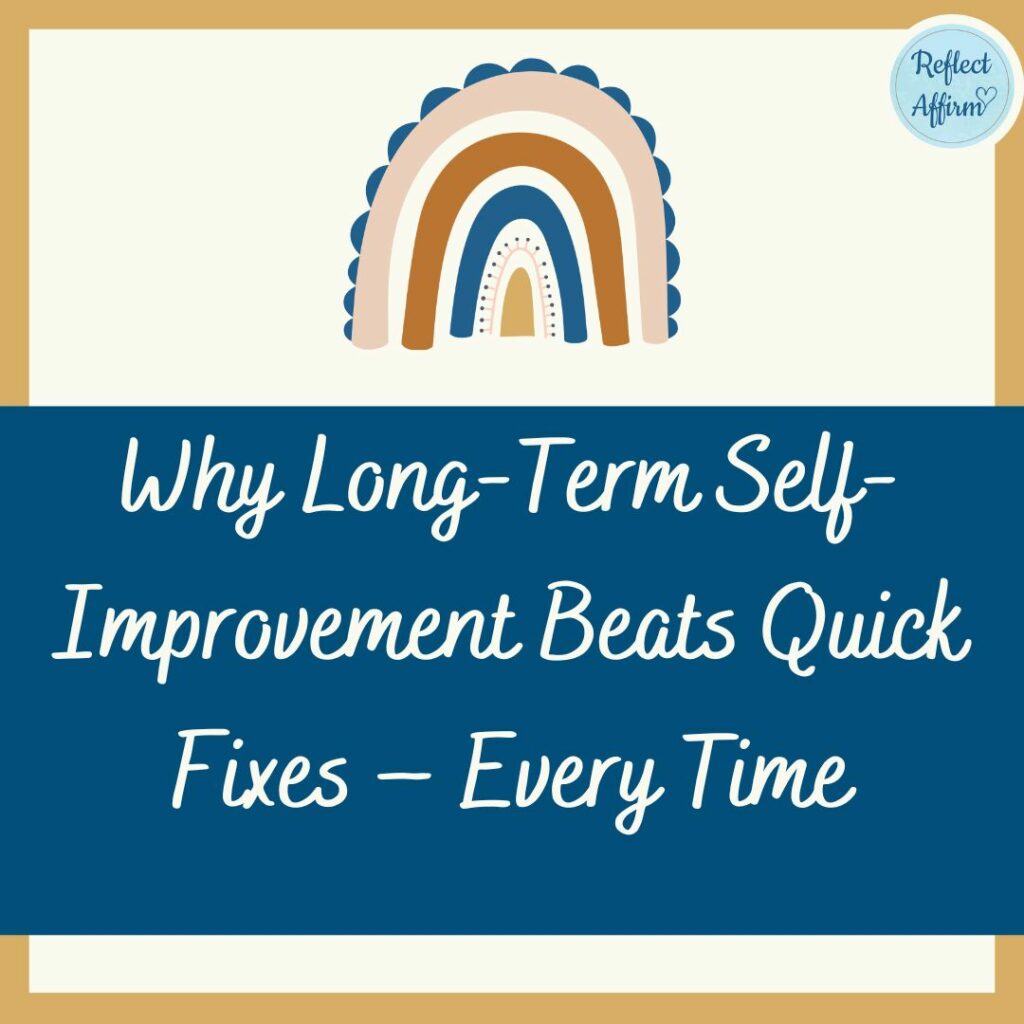
You’ve seen those ads. “Lose 20 pounds in a week!” “Get rich overnight!” “Learn a language in your sleep!” Sounds great, right? But here’s the thing: if it sounds too good to be true, it probably is.
Quick fixes may be tempting, but they’re like sugar rushes. They give you a quick high, then leave you crashing. Long-term self-improvement, on the other hand, is the real deal. It gives you lasting change and genuine happiness.
I’ll explain why it beats quick fixes every single time.
The Problem With Quick Fixes
Quick fixes are everywhere. They promise the world with minimal effort. But let’s get real for a second. Have you ever tried one of these miracle solutions? Maybe it worked… for a day or two. Then what? You’re right back where you started, feeling worse than ever.
The issue with quick fixes is they don’t address the root of the problem. They’re like putting a band-aid on a broken arm. Sure, it may look like you’re doing something, but it’s not actually solving anything. Quick fixes often lead to:
1. Yo-yo effects: You make progress quickly, only to lose it just as fast.
2. Disappointment: You feel like a failure when the miracle cure doesn’t work.
3. Wasted time and money: How much have you spent on products that promised the moon and delivered nothing?

The Power of Long-Term Self-Improvement
Now, let’s talk about the real MVP: long-term self-improvement. It’s not flashy. It doesn’t promise overnight success. But you know what? It works. Here’s why:
1. It’s Sustainable
Long-term improvement is all about making small, consistent changes that add up over time. It’s like compound interest for your life. A little bit each day may not seem like much, but over months and years, the results are mind-blowing.
Think about it. If you improved just 1% each day, after a year, you’d be 37 times better than when you started. That’s the power of consistency and patience.
2. It Builds Real Skills
Quick fixes often rely on tricks or shortcuts. Long-term improvement is about developing genuine skills and knowledge. It’s the difference between memorizing a few phrases in a new language and actually becoming fluent.
When you commit to long-term improvement, you’re not just changing surface-level behaviors. You’re rewiring your brain, creating new neural pathways that stick around for the long haul.
3. It Boosts Your Confidence
There’s something incredibly empowering about seeing yourself make progress over time. It’s not just about reaching a goal. It’s proving to yourself that you have the power to change and grow.
This boost in confidence doesn’t just affect the area you’re working on. It spills over into every aspect of your life. You start to believe in yourself more, take on bigger challenges, and push yourself further than you ever thought possible.
4. It’s Flexible
Life is unpredictable. Quick fixes often fall apart at the first sign of trouble. Long-term improvement, on the other hand, is all about adapting and adjusting as you go.
When you’re focused on gradual progress, setbacks aren’t the end of the world. They’re just bumps in the road, opportunities to learn and grow stronger.
5. It Changes Your Identity
This is perhaps the most powerful aspect of long-term self-improvement. Over time, it doesn’t just change what you do; it changes who you are. When you consistently work on yourself, you start to see yourself differently.
You’re no longer someone who “tries to exercise;” you become an athlete. You’re not “trying to eat healthy;” you become health-conscious. This shift in identity makes your new habits stick because they’re now part of who you are.
How to Commit to Long-Term Self-Improvement
Alright, you’re sold on the idea of long-term self-improvement. But how do you actually do it? Here are some practical steps to get you started:
1. Set Clear, Realistic Goals
Start by figuring out what you really want. Not what you think you should want or what others expect from you. What changes would genuinely make your life better?
Once you have a big goal, break it down into smaller, manageable steps. Instead of “get in shape,” try “walk for 15 minutes every day this week.” Small wins add up and keep you motivated.
2. Focus on Systems, Not Just Goals
Goals are great, but systems are what get you there. For example, a goal may be “lose 20 pounds.” A system may be “prepare healthy meals every Sunday for the week ahead.”
Systems relieve pressure and make progress automatic. They help you change your daily habits instead of just focusing on the end result.
3. Track Your Progress
Keep a record of what you’re doing and how you’re improving. It doesn’t have to be complicated; a simple journal or app can do the trick.
Tracking helps you see how far you’ve come, especially on days when you feel like you’re not making progress. It’s also a great way to identify what’s working and what isn’t.
4. Embrace the Process
Long-term improvement isn’t always exciting. There will be days when you don’t feel like showing up but do it anyway.
Learn to love the process, not just the results. Find ways to make your new habits enjoyable. If you’re trying to read more, find books you love. If you’re exercising, choose activities that are fun for you.
5. Be Patient and Kind to Yourself
Remember, you’re in this for the long haul. There will be setbacks and slow periods, and that’s normal and okay.
Don’t beat yourself up over mistakes or slow progress. Treat yourself with the same kindness and patience you’d offer a good friend.
6. Surround Yourself with Support
Long-term improvement is easier when you’re not going it alone. Find people who support your goals and inspire you to keep going.
This could be friends, family, or even online communities. Share your journey with them. Celebrate your wins together and lift each other up during tough times.
7. Keep Learning and Adjusting
Stay curious. Read books, listen to podcasts, take classes. The more you learn, the more tools you have for self-improvement.
Be willing to adjust your approach as you go. What works for someone else may not work for you, and what worked for you last year may not work now. Stay flexible and open to new ideas.

The Long-Term Payoff
Here’s the best part about long-term self-improvement: it doesn’t just change one area of your life; it changes everything.
When you commit to ongoing growth and development, you become more resilient. You handle stress better. Your relationships improve. You become more creative and productive at work.
But maybe, most importantly, you gain a deep sense of satisfaction and purpose. You’re not just drifting through life anymore; you’re actively shaping it into what you want it to be.
Your Journey Starts Now
Long-term self-improvement isn’t always easy. But it’s real, it’s lasting, and it’s infinitely more rewarding. Whatever it is, do it today. Then do it again tomorrow. And the next day. Before you know it, you’ll look back, amazed at how far you’ve come.
Remember, the journey of a thousand miles begins with a single step. Your journey to a better you starts right now. So forget the quick fixes. Embrace the journey. Your future self will thank you for it.




